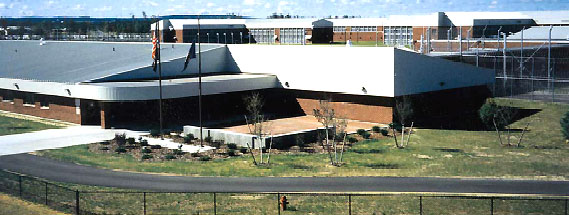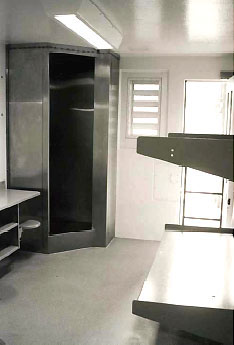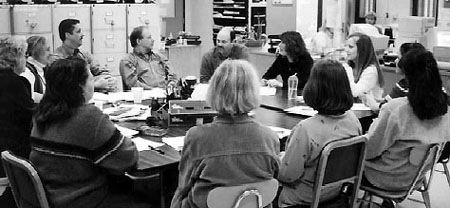UpstateIn March of 1998, construction began on one of the most technologically advanced prisons in New York state. Appropriately called Upstate – this massive maximum-security prison in the town of Malone is a mere 10-minute drive from the Canadian border – the facility is unique among the system’s 70 prisons. Upstate has the capacity to house 1,500 inmates, 1,200 of whom are in disciplinary lookdown for 24 hours a day with the exception of one hour of court-mandated exercise, in 750 double-occupancy cells. Designed to segregate from the general population those inmates who chose to assault staff and others and disobey prison rules, the construction of Upstate and an additional 900 double occupancy maximum-security cells in the late 1990s has led to a much safer prison system. Inmates know that the Department now has disciplinary space to house them if needed, and that realization has helped fuel steep declines in inmate-on-staff and inmate-on-inmate assaults. In short, Upstate is doing exactly what officials had hoped it would do. With the Department facing a shortage of maximum security space in the mid-1990s the state Legislature in July of 1997 approved Governor Pataki’s 1997-98 Executive Budget proposal to add 1,550 such cells to the system. It was the largest cell expansion authorized since the construction of Attica was approved in 1929 and included plans for construction of the state’s first maximum-security facility since Southport opened in 1988. Southport itself was constructed as a disciplinary housing unit with limited support service. Besides authorizing construction of a 750-cell, double occupancy maximum-security facility that would eventually become Upstate, the budget authorized construction of eight 100-cell, double-occupancy maximum-security disciplinary units on the grounds of eight medium-security facilities. Known as S-blocks, these units have also been instrumental in ensuring a safer system for staff and others. . . .
Department-wide, there was a 38 percent decline in inmate-on-staff assaults between 1993 (997) and 2002 (621) during a period in which the inmate population increased by 4 percent, from 64,569 to 66,928 at the end of last year. There was also a 44 percent decline in the number of inmate-on-inmate assaults since 1993, 1,322 down to 735, often the result of staff intervening to prevent or break up such incidents. Additionally, there was a 39 percent decline in contraband, from 2,863 incidents to 1,755, meaning staff is doing an even better job of confiscating contraband and preventing its introduction into facilities. . . . Malone became the final selection for the new prison after officials discounted their initial site in Tupper Lake because of environmental and legal problems that, according to the Department of Environmental Conservation, would have prevented construction there. A total of 535 full-time employees and an annual payroll of $21.3 million was authorized for Upstate with 366 of those positions designated as security posts. Upstate’s 23 buildings occupy 600,000 square feet and cover 70 acres. Commissioner Goord chose to call the new prison Upstate from among the names suggested by community residents, which also included Border, Flat Rock and North Country. He decided upon Upstate in recognition of the consistency of giving facilities regional names, such as Mid-State in Marcy, Eastern in Napanoch, Downstate in Fishkill and Mid-Orange in Warwick. Upstate continues a trend of prison construction in the North Country that has helped boost the economy by providing thousands of good-paying jobs to area residents. Besides Upstate, the North Country – which encompasses Clinton, Franklin and Essex counties – is home to nine other prisons: Adirondack, Altona, Bare Hill, Camp Gabriels, Chateaugay, Clinton, Franklin, Lyon Mountain and Moriah Shock. The first of those, Clinton, opened in 1845. More than 3,800 Adirondack region residents are employed at the 10 prisons in a host of capacities, including serving as doctors, secretaries, counselors, physical plant operators, academic teachers, nurses, vocational instructors, cooks, truck drivers, hearing officers, chaplains, electricians and plumbers – as well as security personnel. The layout at Upstate is quite different than that at other prisons. Those inmates housed in disciplinary status in Upstate’s double cells rarely encounter a prison hallway, unless they’re going for an approved visit or medical call. That’s because located at the rear of each cell is an enclosed exercise area where the inmates go for their one hour of court-mandated daily exercise; the same is the case at the S-blocks. This means employees do not have to run the risk of being assaulted while escorting an inmate to a communal-type outdoor exercise yard and also frees them up to perform other vital security duties. Each of the cells at Upstate – identical to those at the new 100- cell, double-occupancy S-blocks –consists of 105 square feet, making them the largest in the system. Each of the 600 Upstate cells designated for inmates to be housed around-the- clock also are equipped with a shower and toilet, further reducing the need for a security escort. The cadre inmates stay in identical cells. If they’re not assigned to a particular program during the day, they can access their enclosed recreation areas at the rear of their cells. Evenings, if there’s enough inmate interest, the cadre inmates can recreate in the yard or in the gymnasium.
Upstate received its first transfers, a contingent of cadre inmates to ready the facility for further occupancy, on July 6, 1999. The inmates came from Bare Hill, Downstate and Sing Sing. Upstate reached its maximum capacity of 1,500 inmates on August 23 of that year. As a result of Commissioner Goord’s decision to “right-size” the prison system, 160 of the disciplinary cells at Upstate were reclassified as single cells in December 2001. All inmates that are sent to Upstate are designated for placement in either single or double cells by Classification and Movement. Despite their disciplinary housing status, inmates at Upstate, like those at other disciplinary housing units, have daily access to limited services and programs aimed at trying to ensure that they behave in the general population once they’re transferred from the facility. And all Upstate inmates in disciplinary status are provided with an incentive not to act up and follow the rules. Upstate utilizes the Progressive Inmate Movement System (PIMS) as well as the Department’s Tier 3 Disciplinary system to address inmate violations of Department and facility rules and regulations. . . . If an inmate follows the rules and doesn’t cause any problems for staff and others, the system can extend him some special privileges such as increased access to commissary purchases, headphones, additional clothing allowances or additional shower and exercise periods. . . . By reaching certain acceptable performance levels and classification status under PIMS, Upstate inmates are also given the opportunity to participate in cell study programs and a pilot substance abuse cell study program. Upstate inmates in disciplinary status also have an opportunity to have books and periodicals from the law library brought to their cells, as well as publications from the general library. They are also provided regular access to ministerial services at their request and can meet with counselors and health care professionals. Those with appropriate behavior histories can also meet with their families on a limited basis. They are also not sitting alone in their cells 24 hours a day as they have a cell mate with whom they can communicate and play board games. More benefits for those not in disciplinary status The 300 cadre inmates at Upstate are given the chance to access even more programs and services based on the fact that they are not in disciplinary housing status, although they are not as extensive as what’s offered at other prisons throughout the state.
The cadre inmates are allowed movement out of their cells, primarily to go to their work assignments. They are an integral part of the daily operations at Upstate. They work in the laundry, storehouse, state shop, libraries, food services area and other places. They also work as library clerks and porters and are responsible for preparing and transporting food to inmates in the disciplinary units, maintaining the grounds and transporting library and others materials to inmates. The cadre inmates also have access to a large gymnasium, an outdoor recreation yard and a recreation room with a fully equipped weight room. Cadre inmates can also participate in a cell study program from Adult Basic Education (ABE) through the GED level. GED testing was established in 2001, which resulted in 10 successful graduates. Alcohol and Substance Abuse Treatment (ASAT) programming is also made available to cadre inmates. Other programs include guidance and ministerial services. Cadre inmates are also provided areas and times for ample worship of all denominations. “It’s clear to see our policy when you take a look at the operations of Upstate,” said Commissioner Goord. “If . . . an inmate behaves, as is the case with Upstate’s cadre inmates, they can access all available programs, benefits and services. It’s clearly the inmate’s choice.” Meeting the challenges of a varied population Upstate was accredited in 2000 by the American Correctional Association (ACA), affirming that it meets nationally acceptable standards in its management and operations. It is preparing for its triennial reaccreditation this year. All 70 state prisons have been accredited by the ACA but Upstate became the first to achieve the unique distinction in less than a year.
Upstate has an extensive medical department. . . . Being able to provide as many in-house medical services as possible allows for inmate movement and/or transportation to be kept to an absolute minimum. Among the services provided by Upstate’s medical department are an infirmary, dental, radiology services, telemedicine, EKG, phlebotomy and mental health. . . . Upstate also has a fully equipped legal library staffed with law library Correction Officers and inmate clerks. Inmates have access to the resources right at the library or they may make a request in writing if they are in disciplinary housing status. Legal materials are delivered to those who are not in cadre on a daily basis. Upstate is also currently operating one of the largest and most extensive general library programs in the Department, processing more than 100,000 book requests a year. It is affiliated with the Clinton/Essex/Franklin Public Library system and through this connection, inmates are afforded interlibrary loans of books and periodicals. Cadre inmates assist in filling orders and checking the books in and out.
The Inmate Records Office at Upstate coordinates a tremendous amount of activity both in incoming and outgoing transfers. Due to the type of inmate housed at Upstate, scheduling court trips for inmates and coordination of employees for court appearances also encompasses many man hours. In order to obtain some efficiencies in this area, a Legal Officewas created in January 2002 to streamline the operation. To date there have been over 30 inmate convictions for charges such as manslaughter, assault, aggravated harassment of a correctional employee, conspiracy and promoting prison contraband. Working in cooperation with Upstate and others, the Franklin County District Attorney’s Office has successfully convicted both visitors and inmates for promoting prison contraband. They have been recognized by the Department as being in the forefront for this kind of prosecution. The curious meet new neighbor North Country residents showed up at a Department-sponsored facility open house to meet and speak with their new neighbors. The tour was conducted several weeks before the first round of cadre inmates arrived, and the turnout was impressive. . . . Each year, staff and inmates participate in Make a Difference Day activities, sponsoring holiday meals to benefit needy North Country residents. Last year, Upstate, Bare Hill and Franklin employees teamed up to assist the Centenary United Methodist Church prepare its annual Thanksgiving Day dinner for the area’s needy. Dinner was served to more than 100 guests at the church and meals were delivered to about 250 homebound people. . . . .Upstate inmates in 2001 received national recognition when they donated $10,000 to the World Trade Center Relief Fund. Return to menu listing NYCHS excerpts of DOCS|TODAY Facility Profiles.
|







